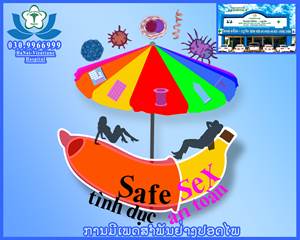
Medical news
HOW IS SAFE SEX?
18/09/2021

HOW IS SAFE SEX? How to have safe sex is one of the main goals of sex education. Safe sex is only really effective when both partners make agreement. This is also the measure helps ensure family planning.
How to have safe sex is one of the main goals of sex education. Safe sex is only really effective when both partners make agreement. This is also the measure helps ensure family planning.
Safe sex is a form of sex that reduces the chance of unwanted pregnancy and does not spread sexually transmitted diseases (STDs).
This means that during intercourse with your partner, there is no physical contact with blood, vaginal secretions and semen.
Thefore, how to have safe sex is one of the main goals of sex education. Safe sex can reduce the risk of unintended consequences, but cannot completely prevent it. Safe sex is only effective when both partners make an agreement together. This is also resolution to help ensure family planning.
Conversely, unprotected sex spreads sexually transmitted diseases (STDs) and leads to unwanted pregnancies. Currently, scientists have identified about more than 20 types of STDs, including HIV/AIDS, gonorrhea, genital warts, genital herpes, genital warts, syphilis, vaginal infections, and genital yeast infections, chlamydia. Many unintended pregnancies force abortions, which seriously affect a woman's health, both physically and mentally.
How to get the safe sex?
Proactive measures to prevent
Currently, the most common method is using a condom, an IUD, or taking birth control pills. However, the only way to make sure no pregnancy and incidence of sexually transmitted infection is to abstain completely relations.
Teens who want safe sex have many options to reduce the risk of unwanted pregnancy. Each different birth control method carries certain risks.
Condoms are one of the most common methods of birth control, but if not used correctly, the risk of pregnancy is relatively high.
Latex condoms are considered an effective prevention against STDs, working by reducing the likelihood of direct contact with genitals or secretions from a sexual partner. This product is widely available and easy for consumers to find and buy. For maximum effectiveness, consumers need to strictly follow the manufacturer's instructions.
Other methods, including hormonal therapy such as birth control pills, physical therapy such as the IUD, diaphragm, and spermicide, need to be consulted and prescribed by a doctor.
Need the collaboration between 2 people
Communication is an important part of safe sex. Talk openly with your partner about safety and the need for protection if you're planning on having sex. Also, if you have a sexually transmitted disease, talk to your partner so they are aware of the importance of protection. However, even if a partner is healthy and has no symptoms of a sexually transmitted disease, it is still possible for them to be infected without even knowing it.
According to statistics, up to three-quarters of women and half of men who are infected with chlamydia do not have any symptoms. As such, the only way to be sure if a person has STDs is to go to the doctor and get tested.
The importance of sex education
Parents, teachers and the community should conduct early sex education for children, especially adolescents. Having an early knowledge about safe sex will help teens get accurate information, help protect themselves, avoid the risk of STDs and unwanted pregnancy.
Sex education for children also helps children delay sex, develop deeper emotional relationships before thinking about sex. In addition, adolescents with knowledge about safe sex tend to choose a more suitable partner, have a healthier relationship, and have fewer health risks.
For gay or lesbian couples, protected sex is a way to help prevent the risk of STDs, especially HIV.
In all cases, complete abstinence from sex is the only safe and secure measure that helps couples avoid unwanted pregnancies and sexually transmitted diseases.
When there is a desire to have a baby, to prepare for a healthy pregnancy, both husband and wife should have their reproductive health checked 3 to 5 months before becoming pregnant.


 Tiếng Việt
Tiếng Việt ຈັນລາວ
ຈັນລາວ English
English